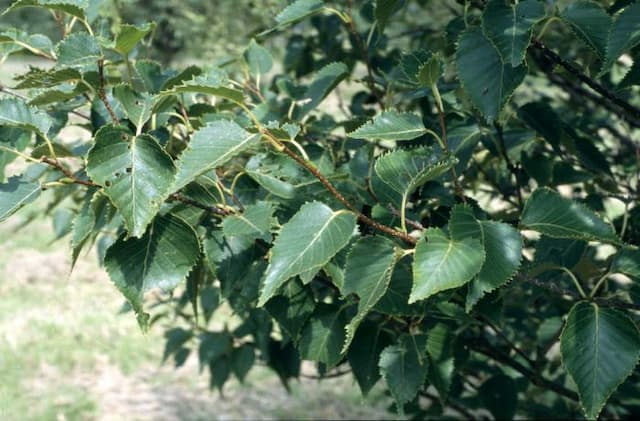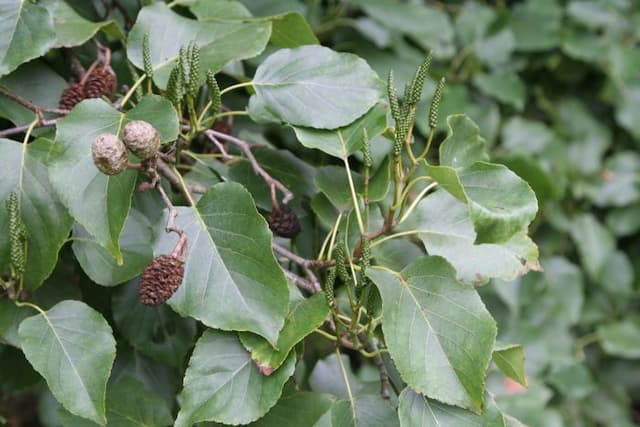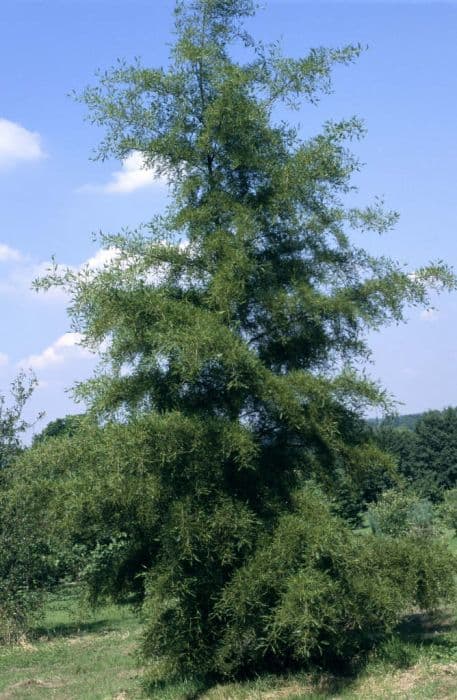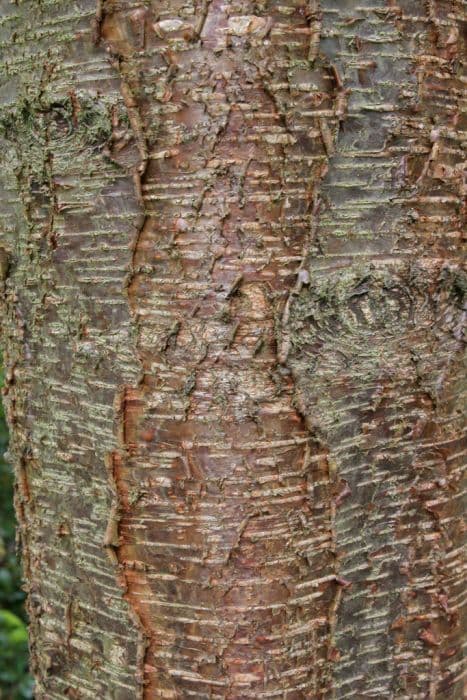Downy Birch Betula pubescens

ABOUT
Betula pubescens, commonly known as downy birch, is a deciduous tree that displays a distinct appearance with different parts that contribute to its overall look. The bark of the downy birch is typically white or light gray, giving it a bright and easily recognizable presence in its natural habitat. With age, the bark may become more rugged with deep furrows and black fissures, adding to its textured appearance. The tree's branches extend upwards and outwards, often forming a somewhat pyramidal to rounded shape. The twigs are slender and, as suggested by its common name, feel soft and downy when touched. Winter buds are small and conical, adding subtle detail to the branches. The leaves of the downy birch are another defining characteristic. With a roughly triangular shape, they have a rounded base and are pointed at the tip. The leaves are somewhat jagged on the edges, creating a serrated look, and they are attached to the branches by slender stems. During the growing season, leaves exhibit a lush green color, which turns to bright yellow before falling off in the autumn. Flowers of the downy birch are not conspicuous like those of many other plants. Instead, they are presented in structures called catkins. Male catkins are long and pendulous, contrasting with the shorter, upright female catkins. The seeds produced by the female catkins typically have small wings that help them disperse in the wind. The root system of downy birch is generally shallow, spreading widely to anchor the tree and absorb moisture and nutrients from the soil. The combination of its white bark, elegantly serrated and colored leaves, and unique catkins gives the downy birch a distinctive appearance that can be appreciated in various landscapes where it naturally occurs.
About this plant
 Names
NamesFamily
Betulaceae
Synonyms
Downy Birch, White Birch, Moor Birch, Hairy Birch
Common names
Betula alba var. pubescens, Betula carpatica, Betula humilis, Betula montana, Betula odorata, Betula pendula var. pubescens, Betula pubescens var. leioclada, Betula pubescens var. litwinowii, Betula pubescens var. pumila, Betula tomentosa.
 Toxicity
ToxicityTo humans
Downy birch is not known to be toxic to humans. In fact, various parts of the plant, such as the sap, have been traditionally used for consumption. However, ingestion of any non-edible part of any plant may potentially cause a reaction due to individual allergies or sensitivities.
To pets
Downy birch is not recognized as being poisonous to pets. It is not commonly listed among plants that pose a toxicity risk to animals. However, as with humans, individual animals may have allergies or sensitivities that could result in mild to moderate gastrointestinal upset if they ingest parts of the plant. It is always advisable to monitor pets and prevent them from consuming non-food plants.
 Characteristics
CharacteristicsLife cycle
Perennials
Foliage type
Deciduous
Color of leaves
Green
Flower color
Yellow
Height
30 feet (9 meters)
Spread
20 feet (6 meters)
Plant type
Tree
Hardiness zones
2
Native area
Europe
Benefits
 General Benefits
General Benefits- Ecosystem support: Betula pubescens, commonly known as Downy Birch, provides habitat and food for a wide range of wildlife, including numerous bird species and insects.
- Ornamental value: With its attractive bark, graceful branches, and changing foliage, Downy Birch is often used in landscape design for aesthetic appeal.
- Soil improvement: Downy Birch can grow in poor soils and helps to improve soil quality over time through leaf litter and root activity.
- Climate adaptation: This species of birch is resilient to cold climates, making it an important part of ecosystems in northern latitudes.
- Erosion control: The root system of Downy Birch stabilizes soil and can help prevent erosion, particularly in wetland areas and on slopes.
- Water management: Downy Birch is often found in wet habitats and can play a role in water level regulation and the reduction of flooding.
- Wood production: The wood of Downy Birch is used for a variety of products, including furniture, plywood, and paper.
- Biodiversity: By providing diverse habitats, Downy Birch contributes to the overall biodiversity within its native range.
- Carbon sequestration: As a tree, Downy Birch captures carbon dioxide from the atmosphere, contributing to carbon sequestration efforts.
 Medical Properties
Medical Properties- Diuretic: Betula pubescens, also known as Downy Birch, has been traditionally used to promote the production of urine, possibly supporting the urinary system.
- Antirheumatic: The plant's components are believed to help in the treatment of rheumatic pain.
- Anti-inflammatory: Downy Birch may possess anti-inflammatory properties, which could help reduce inflammation.
- Analgesic: It is sometimes used for its pain-relieving effects.
- Depurative: Betula pubescens may act as a blood purifier, helping to detoxify the body.
- Antiseptic: The sap and other extracts from the plant may have antiseptic qualities, potentially useful in preventing or combating infection.
 Air-purifying Qualities
Air-purifying QualitiesThis plant is not specifically known for air purifying qualities.
 Other Uses
Other Uses- The inner bark of the Downy Birch can be ground into a flour substitute or extender, which has been used historically during times of famine.
- The sap from Downy Birch can be tapped and fermented to make birch wine or vinegar, providing a unique flavor profile in culinary applications.
- Downy Birch wood can be utilized in the manufacture of high-quality charcoal, employed in artistic drawing and by blacksmiths.
- The wood is also suitable for making durable and attractive plywood, commonly used in furniture and flooring.
- Traditional Scandinavian cultures have used the flexible branches of this tree to craft birch-bark shoes, which were light and waterproof.
- Due to its lightness and strength, Downy Birch wood is sometimes used to build lightweight canoes and other small watercraft.
- Young twigs and branches can be woven into baskets, offering an eco-friendly option for storage and transport of goods.
- The bark of Downy Birch can be processed into birch bark tar, an adhesive and waterproofing agent used historically for fixing items or caulking boats.
- The fibers from the delicate bark have been used to create paper, adding a rustic and unique texture to the finished product.
- The tree's natural resilience and ability to thrive in cold climates make it a preferred species for reforestation and land reclamation projects.
Interesting Facts
 Feng Shui
Feng ShuiThe Downy Birch is not used in Feng Shui practice.
 Zodiac Sign Compitability
Zodiac Sign CompitabilityThe Downy Birch is not used in astrology practice.
 Plant Symbolism
Plant Symbolism- Adaptation: The Downy Birch is highly adaptable, able to thrive in cold environments and poor soil, symbolizing the ability to thrive in difficult conditions.
- Purification: Historically, birch trees have been associated with purification and renewal, often used in traditional rituals to drive out evil spirits.
- New Beginnings: The birch's propensity to be one of the first trees to grow in a cleared area signifies new beginnings and starting fresh.
- Love: In some cultures, birch branches are used to create wreaths and other decorations for weddings, symbolizing love and fertility.
- Protection: In folklore, birch trees are believed to protect against evil and negativity, partly due to their bright, white bark that stands out in the forest.
 Water
WaterDowny Birch requires consistent moisture, especially during its early growth stages and in dry conditions. It should be watered thoroughly, allowing the soil to become moist but not waterlogged. On average, provide about 1 to 1.5 gallons of water per week, depending on weather conditions. During hot, dry spells, the frequency of watering may need to increase to maintain soil moisture. It's essential to ensure that the tree receives enough water to reach the deep roots, promoting healthy growth.
 Light
LightFor optimal growth, the Downy Birch should be planted in a location with full sun to partial shade. This tree thrives in areas that receive at least 4-6 hours of direct sunlight per day. However, it can tolerate some light shade, especially in hotter climates. The best spot is one where the tree is exposed to unfiltered sunlight for the majority of the day.
 Temperature
TemperatureDowny Birch is adaptable to a wide range of temperatures and can withstand cold conditions down to -40 degrees Fahrenheit. It can also survive in regions with summer temperatures up to 86 degrees Fahrenheit, although it prefers cooler climates. The ideal temperature range for the Downy Birch is between 50 and 70 degrees Fahrenheit.
 Pruning
PruningPruning the Downy Birch is important for removing dead or damaged branches, which helps maintain tree health and appearance. Prune during the late fall or winter when the tree is dormant to minimize stress. Occasional thinning of the crown can also improve air circulation. Pruning every 3 to 5 years is usually sufficient, and the best time is during the tree's dormancy.
 Cleaning
CleaningNot needed
 Soil
SoilDowny birch thrives in moist, well-draining soil with a pH range of 4.0 to 6.0. A good soil mix can include peat, sand, and loamy soil to ensure proper moisture retention and drainage.
 Repotting
RepottingDowny birches are large trees and typically planted outdoors; repotting is not applicable for mature trees. However, if growing a sapling in a container, repot every two to three years.
 Humidity & Misting
Humidity & MistingDowny birch does not have specific humidity requirements, as it tolerates a wide range of outdoor conditions.
 Suitable locations
Suitable locationsIndoor
Needs bright light, moderate watering; not suited for long-term indoor growth.
Outdoor
Plant in moist, well-drained soil; full sun to partial shade.
Hardiness zone
2-7 USDA
 Life cycle
Life cycleBetula pubescens, commonly known as downy birch, begins its life cycle as a tiny seed, which requires cold stratification to break dormancy and promote germination. Upon germination in early spring, the seedling establishes itself, rapidly growing into a young sapling and developing its characteristic downy twigs. As the sapling matures into an adult tree, it develops a slender trunk and a canopy of deciduous leaves that engages in photosynthesis throughout the spring and summer, after which the leaves turn yellow and are shed in autumn. The downy birch reaches reproductive maturity within a few years, producing catkins; the male catkins release pollen while the female catkins develop into small cones that disperse seeds by wind. The adult birch can live and reproduce for several decades, with winter dormancy as a regular part of its cycle, allowing it to survive the cold conditions of its native habitats. After the tree's life span is concluded, it dies and decomposes, returning nutrients to the soil and potentially giving rise to new birch seedlings.
 Propogation
PropogationPropogation time
Spring to early summer
The most popular method of propagation for the Betula pubescens, commonly known as the Downy Birch, is by seed. The optimal time for sowing the seeds is in spring after the threat of frost has passed. Downy Birch seeds require a period of cold stratification to mimic winter conditions and break dormancy, which can be achieved by storing the seeds in a refrigerator at about 39 degrees Fahrenheit (4 degrees Celsius) for around 4 to 6 weeks. After stratification, the seeds should be surface sown on a well-drained soil mix and kept moist until germination, which typically occurs within a few weeks. For successful growth, the seedlings need plenty of light and should be protected from extreme weather conditions until they are strong enough to be planted out.









